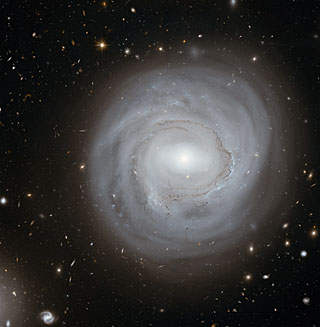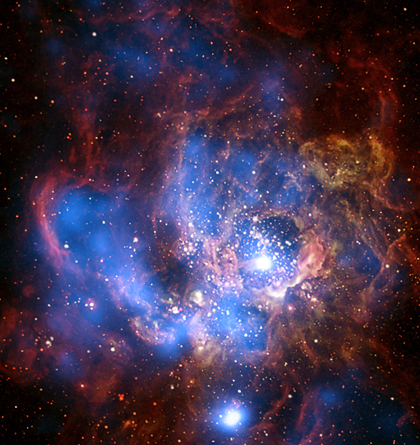Last week I noted that there have been some serious questions raised in a paper by Gregory Hickok about the "mirror neuron theory of action understanding".
I've now read the paper, and there's a lot that could be said on the topic.
But first, what's the discussion about to begin with?
"Mirror neurons" have received a lot of speculative attention in the popular science media. I've done some of that myself. (See
here,
here,
here,
here.)
So what
is a "mirror neuron"? According to
Wikipedia (which is as good a source as any for popular usage of a term), "A mirror neuron is a neuron which fires both when an animal acts and when the animal observes the same action performed by another (especially conspecific) animal. Thus, the neuron "mirrors" the behavior of another animal, as though the observer were itself acting."
That definition needs to be unpacked a little, for the sake of being specific about what's under discussion, even if we have to deviate from what is popularly understood. So, more specifically, a mirror neuron is one that's found in a motor control area of an animal's brain. It's not the only type of neuron there, but it does activate when the animal performs specific motor actions (different ones for different neurons).
The other characteristic that a mirror neuron is presumed to have is that it
also activates when the animal perceives another animal performing the same action that causes activation of the neuron in the observing animal.
Notice what's
not being defined as a mirror neuron. We aren't talking about just any neuron which activates when an animal perceives another animal performing some action. If that were the definition, it would be somewhat tautologous to assert that such a neuron helps the observing animal to "understand" the actions of another animal. Clearly, any animal that is capable of "understanding" the actions of other animals (of the same or even different species) must have some action-specific neurons that activate when observing actions of other animals.
It would not be pointless to discuss such things, but we would be more into the area of what it means for an animal to "understand" actions of another and how that might happen. That's a much broader issue, even applied to particular species, especially humans.
However, as soon as we agree that we're talking about certain neurons only in the limited sense mentioned above, the question arises of whether such neurons exist at all. And the interesting thing is that there are generally accepted research findings that such neurons
do exist – in one particular species:
macaque monkeys. These are one particular species of
old world monkeys that happen to be used frequently in neurobiological research, because (being primates) they're a lot closer to humans than, say, rats, but also a lot more convenient and less expensive to work with than humans.
But note that, again according to Wikipedia, "The only animal in which mirror neurons have been studied individually is the macaque monkey. In these monkeys, mirror neurons are found in the inferior frontal gyrus (region F5) and the inferior parietal lobule." Apparently, evidence that mirror neurons even exist in other species, especially humans, is sparse to non-existent.
That's one of the main points made in the Hickok paper I've been referring to (
Eight Problems for the Mirror Neuron Theory of Action Understanding in Monkeys and Humans). Specifically:
there have been a host of studies aimed at investigating the ‘‘mirror system’’ in humans, but much of this work has investigated behaviors that mirror neurons could not possibly support given their response properties in monkeys, and therefore, the connection between these behaviors and mirror neurons is tenuously based on a chain of assumptions: Mirror neurons exist in humans (there are individual cells that respond both during action execution and action perception), mirror neurons have evolved to support functions in humans that they do not support in monkeys, this evolution has conserved the functional properties found in monkeys, and mirror neurons are responsible for the behavior in question.
Unfortunately, the existence of mirror neurons in humans is still just an assumption. And further, assumptions about what aspects of human cognition mirror neurons (if they exist) might take part in significantly exceed what is known about the function of mirror neurons in monkeys. Hickok provides a partial list of human capabilities sometimes assumed to involve mirror neurons: "speech perception, music perception, empathy, altruism, emotion, theory of mind, imitation, autism spectrum disorder, among others".
Clearly, that list far surpasses merely "action understanding". And it goes far beyond the data, because macaque monkeys are not known to exhibit most of those capabilities. Indeed, they are known
not to have (e. g.) much ability for imitation. So to assume that mirror neurons can be used to explain all of those things requires the assumptions that humans have analogues of macaque mirror neurons, and that such analogues play a significant role in those varied capabilities.
Such assumptions may well provide fruitful hypotheses for future research. But the research to adequately justify such ideas has scarcely begun.
On top of all that, it's not clear how important mirror neurons are for "action understanding" even in macaques. I find two main points in Hickok's paper, and this is one of them. The other is to call into question the importance of a "mirror system" (of neurons in motor-related brain areas) in humans, should such even exist, for "action understanding". Unfortunately, I don't have time in this note to go into more detail on his arguments regarding these points.
I think one has to question what exactly is meant by "action understanding" in the first place. It's certainly a valid question for macaques. We can't even be sure of what it means for a macaque to "understand" anything – since we have no introspective knowledge of the macaque mind. But here's a possible way to operationalize the notion. We might say that "understanding" means an ability to predict what might follow the observation of a specific action in another individual. For example, certain facial expressions might predict further actions, such as overt aggression or attempts at mating behavior.
Many animals certainly have such abilities. Dogs, for instance, obviously know what it means when another dog is seen baring its teeth. But does that mean dogs have analogues of mirror neurons that contribute to this understanding? Do we know whether mirror neurons, even in macaques, assist in predicting future behavior of other individuals? Since I'm hardly an expert in animal behavior, I can't answer those questions.
What all of these questions mean to me is not that we have to give up hope of understanding human characteristics, such as empathy, altruism, imitation, theory of mind, and so forth. Instead, the take-away is that a vast amount of further research work needs to be done in order to establish a sound scientific understanding of the neurobiology of such abilities. The hypothesis that humans have some sort of "mirror system" of neurons that plays a role in empathy, altruism, imitation, etc. is at least a plausible one, inspired by a rough analogy with macaque mirror neurons.
But almost all the research remains to be done that would (1) identify parts of the human brain that comprise a "mirror system", and (2) show that such subsystems underlie each specific case of what we might call "empathetic behavior" in humans. This would appear to be a task similar in difficulty to that of achieving a neurobiological understanding of almost any type of "higher-level" human capability, from abstraction to complex language to long-range planning.
And yet there are good evolutionary reasons for expecting that one or more "mirror systems", in some broader sense, may exist in humans. Very generally, humans have highly developed capabilities for social organization. Such capabilities are needed to enable specific aspects of human social behavior, e. g. the ability to construct elaborate social hierarchies, build complex, enduring social coalitions, and detect covert violators of important social norms. Such capabilities would be evolutionarily favored in selecting for groups that are more cohesive and unified in competition with rivals. (At least if one thinks that
group selection is possible.)
If you don't happen to believe in group selection, there are other reasons that individuals possessing good "empathic skills" would have an adaptive advantage and higher
fitness compared to other individuals.
For example, consider hand-to-hand combat. Humans have always fought bloodily against others of their species, especially members of unrelated tribes. The ability to rapidly and accurately predict the next hostile moves of an opponent bent on one's destruction would have to be ranked as very valuable. Obviously, some individuals are able to become very skilled in "martial arts", which rely on highly sensitive observance of the detailed behavior of others.
More generally, beyond the level of physical combat, the admonition to "know your enemy" has always been excellent advice. Sensitive understanding of the subtleties of body language is an extremely useful skill in many competitive situations, as good poker players and canny negotiators will attest. Being able to understand the goals and intentions of an opponent certainly has evolutionary survival value. And the same ability regarding others in general is just as useful for achieving cooperation.
Understanding the neurobiology of such skills is an excellent, albeit very long-range, research goal. I'm not necessarily skeptical of the possibility of such a reductionistic goal, but I don't expect it to be achieved very soon, either....
One may reasonably ask why, if the actual evidence for a mirror neuron system in humans is so questionable, the idea is also so popular and widely discussed. The answer seems to be that, if valid, the idea provides important support for the philosophy of "
embodied cognition", which holds that the nature of human thinking and emotion is closely tied to the physical body. But that's far too large of an issue to start addressing here.
Tags:
mirror neurons,
neurobiology,
embodied cognitionLabels: mirror neurons, neurobiology, neuroscience



 Subscribe to posts
Subscribe to posts


 Google
Google Delicious
Delicious Diigo
Diigo Twine
Twine StumbleUpon
StumbleUpon






